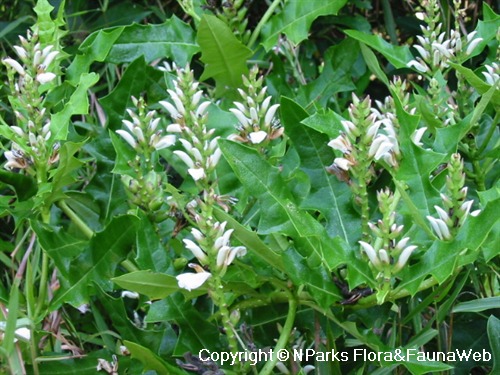
Back
Acanthus ebracteatus Vahl
| Family Name: | Acanthaceae |
| Common Name: | Sea Holly, Jeruju, Jerujah, Jejuru Hitam, Holly-leaved Mangrove, 小花老鼠勒 |
Name
Classifications and Characteristics
| Plant Division | Angiosperms (Flowering Seed Plants) (Dicotyledon) |
|---|---|
| Plant Growth Form | Shrub |
| Lifespan (in Singapore) | Perennial |
| Mode of Nutrition | Autotrophic |
| Plant Shape | Irregular |
| Maximum Height | 1.5 m to 2 m |
Biogeography
| Native Distribution | Tropical Asia, Tropical Australia, Pacific |
|---|---|
| Native Habitat | Shoreline (Mangrove Forest) |
| Preferred Climate Zone | Tropical, Sub-Tropical / Monsoonal |
| Local Conservation Status | Native to Singapore (Vulnerable (VU)) |
Description and Ethnobotany
| Growth Form | It is an erect or sprawling shrub with with decumbent stems. It reaches up to 2 m tall. |
|---|---|
| Roots | It has a tap root system that stays close to the soil surface. |
| Foliage | Its opposite, stalked leaves have leaf blades that are oblong to oval, with toothed leaves that are deeply lobed with spine tips along the leaf margin, shiny dark green above, dark green below, and 7.5–20 by 2.5–6.5 cm. |
| Stems | Stems are hollow and erect. |
| Flowers | Its flowers are in a flowering shoot (spike) to about 8–15 cm long. Its flowers have white petals that turn brown with age. |
| Fruit | Its fruits are oblong and slightly flattened, green to dark green, 2–3 by 1 cm, and contain four large, flat seeds. |
| Habitat | Occurs in the back mangroves, forming an important part of the undergrowth. Also found along river banks near the coast where they are regularly inundated by seawater. It occurs locally at various mangrove forests in Singapore. |
| Similar | It looks superficially similar to Acanthus ilicifolius. |
| Associated Fauna | Provides shelter for small vertebrates. Its flowers are probably bird and insect pollinated. |
| Cultivation | It can be grown submerged in freshwater. |
| Etymology | Greek akanthos, derived from akantha, thorn, prickle; Latin ebracteatus, without bracts |
| Ethnobotanical Uses | Medicinal: Chemicals in the bark have antiseptic properties. A decoction of the
plant is drunk to treat kidney stones. The juice from the leaves is used as a
hair preserver, and to relieve rheumatism. The stem and roots are used for skin
diseases, and longevity. Its boiled seeds are used to poultice boils, and are
also an ingredient for cough medicine along with Averrhoa flowers, black sugar-cane, cinnamon, and crystalline
sugar. A decoction of the seeds is drunk to treat against boils. Others: It accumulates zinc from contaminated soil. |
Landscaping Features
| Landscaping | It is suitable for sunny, waterlogged areas, or in ponds as an emergent. It is tolerant of saline soils and salt sprays as well. |
|---|---|
| Desirable Plant Features | Ornamental Flowers, Ornamental Foliage |
| Landscape Uses | Coastal, Beachfront / Shoreline, Riverine, Pond / Lake / River, Marsh / Bog, Phytoremediation |
| Usage Hazard - Cons | Spines/Thorns - Stem/Branch, Spines/Thorns - Leaf |
Fauna, Pollination and Dispersal
| Pollination Method(s) | Biotic (Fauna) |
|---|---|
| Seed or Spore Dispersal | Abiotic (Explosive Dehiscence) |
Plant Care and Propagation
| Light Preference | Semi-Shade, Full Sun |
|---|---|
| Water Preference | Lots of Water |
| Plant Growth Rate | Moderate |
| Rootzone Tolerance | Waterlogged Soils (Does not Drain Site), Saline Soils / Salt Spray, Easy to Grow |
| Propagation Method | Seed, Stem Cutting (Tip, Herbaceous) |
Foliar
| Foliage Retention | Evergreen |
|---|---|
| Mature Foliage Colour(s) | Green |
| Mature Foliage Texture(s) | Smooth, Glossy / Shiny |
| Foliar Modification | Spine (marginal) |
| Foliar Type | Simple / Unifoliate |
| Foliar Arrangement Along Stem | Opposite |
| Foliar Attachment to Stem | Petiolate |
| Foliar Shape(s) | Non-Palm Foliage (Oblong, Falcate / Curved) |
| Foliar Venation | Pinnate / Net |
| Foliar Margin | Pinnately Lobed / Pinnatifid |
| Foliar Base | Acute |
| Typical Foliar Area | Mesophyll ( 45cm2 - 182.25 cm2 ) |
| Leaf Area Index (LAI) for Green Plot Ratio | 4.5 (Shrub & Groundcover - Dicot) |
Floral (Angiosperm)
| Flower & Plant Sexuality | Bisexual Flowers |
| Flower Colour(s) | White |
|---|---|
| Flower Grouping | Cluster / Inflorescence |
| Flower Location | Terminal |
| Flower Symmetry | Bilateral |
| Inflorescence Type | Spike |
| Flower Transitional Changes | Colour |
Fruit, Seed and Spore
| Mature Fruit Colour(s) | Brown, Green - Light Green |
|---|---|
| Fruit Classification | Simple Fruit |
| Fruit Type | Dehiscent Dry Fruit , Capsule |
References
| References | Yong J, Tan PY, Nor Hafiz Hassan, Tan SN. 2010. A Selection of Plants for Greening of Waterways and Waterbodies in the Tropics. Singapore: Chung Printing . 480 pp. |
|---|
Image Repository
Others
| Master ID | 298 |
|---|---|
| Species ID | 1594 |
| Flora Disclaimer | The information in this website has been compiled from reliable sources, such as reference works on medicinal plants. It is not a substitute for medical advice or treatment and NParks does not purport to provide any medical advice. Readers should always consult his/her physician before using or consuming a plant for medicinal purposes. |










